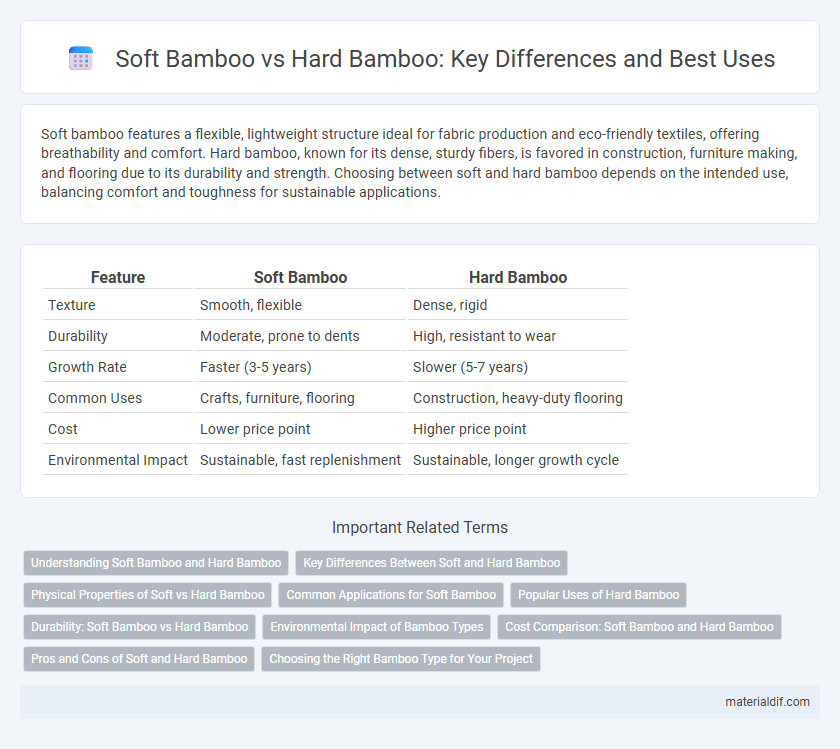Soft bamboo features a flexible, lightweight structure ideal for fabric production and eco-friendly textiles, offering breathability and comfort. Hard bamboo, known for its dense, sturdy fibers, is favored in construction, furniture making, and flooring due to its durability and strength. Choosing between soft and hard bamboo depends on the intended use, balancing comfort and toughness for sustainable applications.
Table of Comparison
| Feature | Soft Bamboo | Hard Bamboo |
|---|---|---|
| Texture | Smooth, flexible | Dense, rigid |
| Durability | Moderate, prone to dents | High, resistant to wear |
| Growth Rate | Faster (3-5 years) | Slower (5-7 years) |
| Common Uses | Crafts, furniture, flooring | Construction, heavy-duty flooring |
| Cost | Lower price point | Higher price point |
| Environmental Impact | Sustainable, fast replenishment | Sustainable, longer growth cycle |
Understanding Soft Bamboo and Hard Bamboo
Soft bamboo typically features thinner walls and flexible stems, making it ideal for crafting lightweight products such as baskets and furniture. Hard bamboo has thicker walls and denser fibers, providing increased strength and durability, which suits construction and flooring applications. Differentiating between the two involves assessing attributes like rigidity, growth rate, and fiber density to choose the appropriate type for specific uses.
Key Differences Between Soft and Hard Bamboo
Soft bamboo species, such as Bambusa vulgaris, are characterized by their more flexible, lightweight stalks and faster growth rates, making them ideal for crafting, paper production, and certain construction uses. Hard bamboo varieties, including Phyllostachys edulis, possess denser, thicker walls with higher lignin content, providing superior strength, durability, and resistance to wear, suitable for heavy-duty flooring, furniture, and structural applications. The key differences between soft and hard bamboo lie in mechanical properties, wall thickness, and applications driven by their fiber composition and growth patterns.
Physical Properties of Soft vs Hard Bamboo
Soft bamboo features a lower density and reduced lignin content, resulting in greater flexibility and lighter weight compared to hard bamboo. Hard bamboo exhibits higher density, increased tensile strength, and greater hardness due to a more rigid fiber structure and elevated silica content. These physical differences influence their respective applications, with soft bamboo preferred for lightweight crafts and hard bamboo suited for construction and structural uses.
Common Applications for Soft Bamboo
Soft bamboo, known for its flexibility and lightweight properties, is commonly used in crafts, furniture, and construction of decorative items. Its smooth texture makes it ideal for weaving baskets, mats, and traditional musical instruments. Soft bamboo is favored in applications where easy shaping and gentle durability are crucial, such as in interior design and artisanal products.
Popular Uses of Hard Bamboo
Hard bamboo, known for its dense fiber structure and superior strength, is widely used in construction, furniture making, and flooring due to its durability and resistance to wear. Its robust properties make it ideal for outdoor applications such as decking, scaffolding, and fencing, where long-lasting performance under harsh weather conditions is essential. Hard bamboo's versatility extends to crafting tools, utensils, and musical instruments, leveraging its strength and resilience for functional and artistic purposes.
Durability: Soft Bamboo vs Hard Bamboo
Soft bamboo offers moderate durability suitable for indoor furniture and light construction, resisting wear but less effective against heavy impact and moisture. Hard bamboo features superior durability, with dense fiber structures that withstand abrasion, strong impacts, and outdoor elements, making it ideal for flooring and heavy-duty applications. The difference in lignin content and cellular density between soft and hard bamboo directly influences their longevity and resistance to environmental stressors.
Environmental Impact of Bamboo Types
Soft bamboo varieties, such as Guadua and certain Phyllostachys species, generally have faster growth rates and require fewer pesticides, contributing to lower environmental footprints. Hard bamboo types, including some temperate species like Fargesia, grow slower and may need more intensive management, which can increase resource usage and carbon emissions. Selecting soft bamboo for cultivation optimizes sustainability by maximizing carbon sequestration while minimizing land and water consumption.
Cost Comparison: Soft Bamboo and Hard Bamboo
Soft bamboo generally costs less than hard bamboo due to its faster growth rate and lower processing requirements, making it a budget-friendly option for flooring and furniture. Hard bamboo, prized for its durability and density, commands a higher price but offers greater longevity and resistance to wear. When comparing costs, consider not only the initial price but also maintenance expenses and lifespan, where hard bamboo often provides better long-term value despite its higher upfront investment.
Pros and Cons of Soft and Hard Bamboo
Soft bamboo offers flexibility and lightweight properties, making it ideal for crafting delicate items and furniture with intricate designs, but it lacks the durability for heavy construction. Hard bamboo provides superior strength and resistance to wear, suitable for flooring and structural applications, though it can be more brittle and challenging to work with. Both types vary in density and moisture content, influencing their longevity and maintenance requirements in different environments.
Choosing the Right Bamboo Type for Your Project
Soft bamboo varieties, such as Guadua and Phyllostachys, offer flexibility and are ideal for lightweight constructions or decorative purposes due to their pliable yet sturdy nature. Hard bamboo, including species like Moso and Dendrocalamus, provides superior strength and durability, making it suitable for heavy-duty building projects and outdoor structures. Selecting the right bamboo type depends on the project's structural requirements, environmental exposure, and the desired balance between flexibility and rigidity.
Soft bamboo vs hard bamboo Infographic

 materialdif.com
materialdif.com